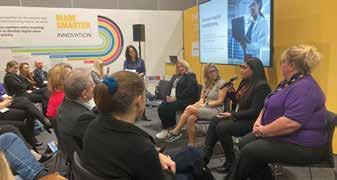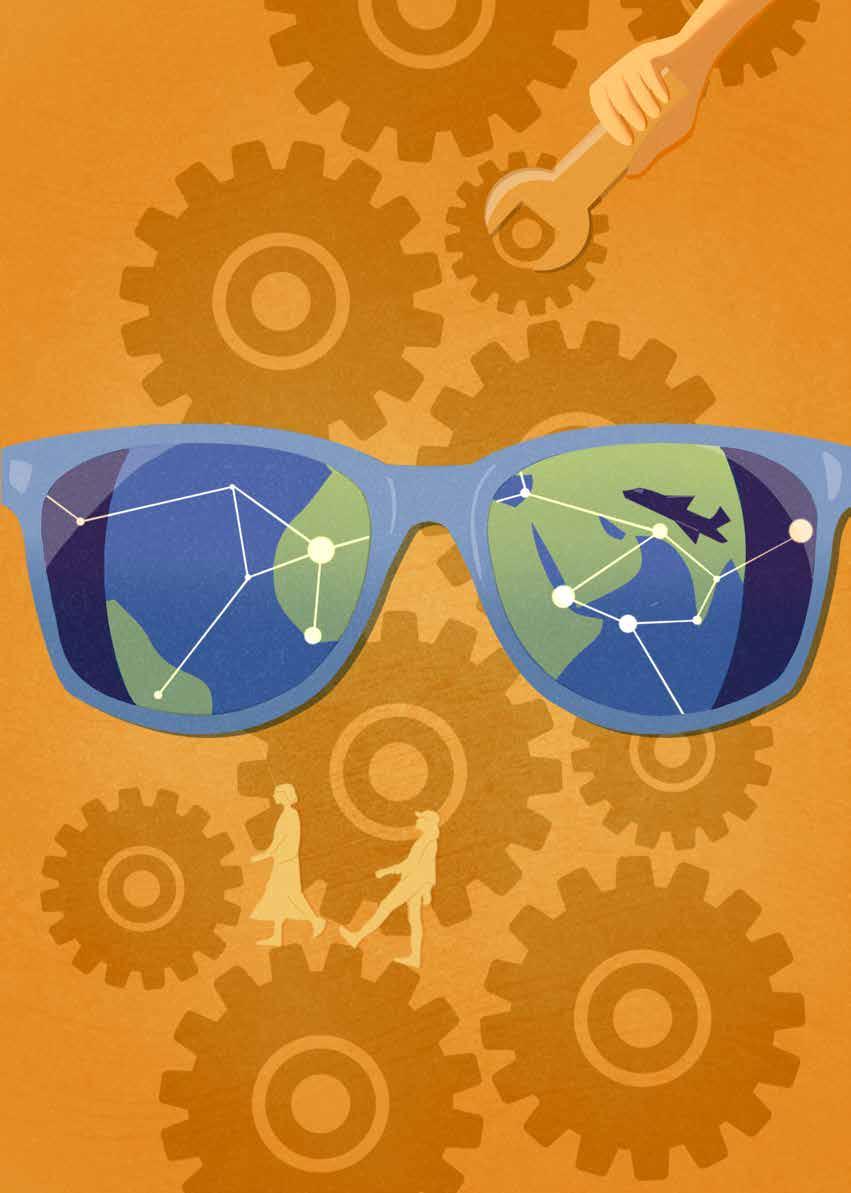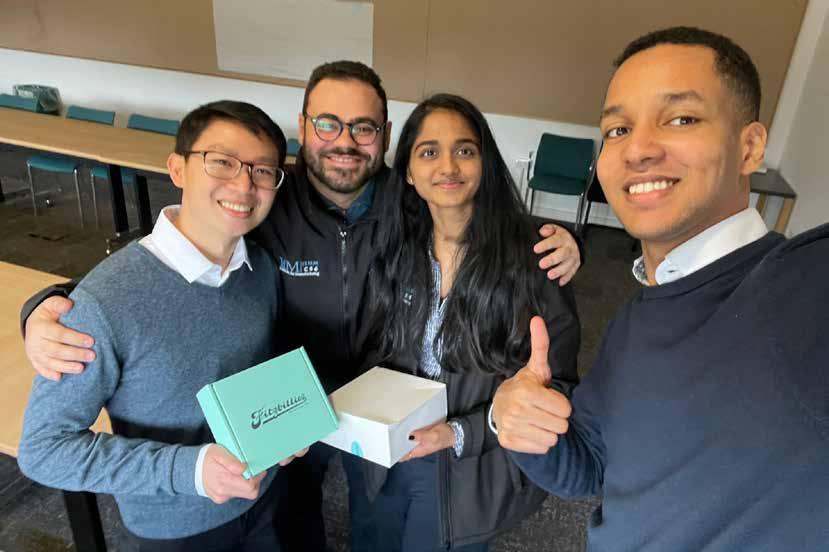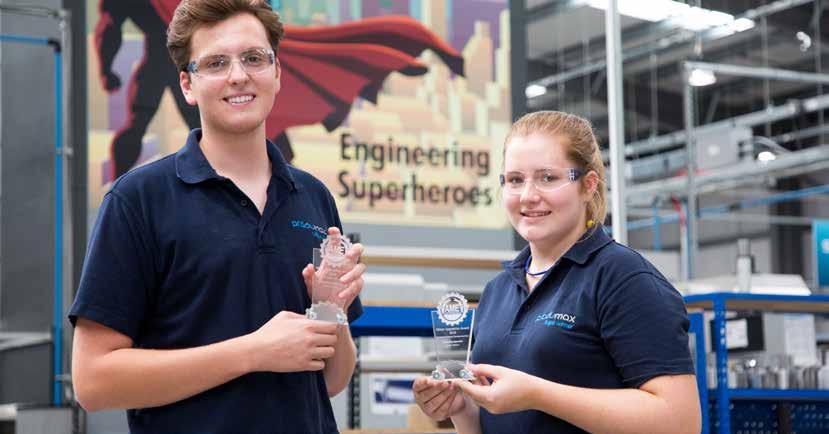

INSTITUTE FOR MANUFACTURING (IfM)
The IfM is part of the University of Cambridge’s Department of Engineering. We are a dynamic body of researchers, educators, practitioners, professionals and technical experts contributing to worldleading research and education. With a focus on manufacturing industries, the IfM creates, develops and deploys new insights into technology, management and policy.
IfM ENGAGE
IfM Engage is an embedded knowledge transfer company within the Institute for Manufacturing (IfM). We combine research excellence and industry expertise to conduct bespoke strategic consultancy, talent and leadership development and company membership programmes. Our profits are gifted to the University of Cambridge to fund future research.
COVER IMAGE
Credit: Amy Reinecke/ Institute for Manufacturing
SUSTAINABILITY
Editor: Elizabeth Tofaris
Design: www.dangould.co.uk
For the latest articles and news from the IfM, sign up to our IfM Insights email at: www.ifm.eng.cam.ac.uk/research/ifmreview/sign-up/ or by scanning the QR code.

CONTENTS
Changing how we talk – and think –about manufacturing
IfM students help to turn 100-yearold bakery into thriving online business

From grant to scaled-up manufacturing: Roadmapping for success


Algorithm helps to correct 3D printing errors
Digital transformation on a shoestring
Transforming manufacturing with autonomous supply chains

Digital twins for the space sector

Innovation methods identify how to address root causes of depression in young people
Quick-win sustainability strategies from IfM
Engineering superheroes: IfM Engage helps aerospace company spread its wings

Beyond COVID-19: What can be done to enhance the resilience of smaller manufacturing firms?
The Innovation Report: How does the UK measure up?
Putting the user at the centre: The future of digital health apps
WELCOME TO ISSUE 14
As I reflect in our lead article, the ability to make things is the bedrock of strong economies and societies. However, in the UK, manufacturing is too often seen as “something we don’t really do much of anymore” or “a problem to be fixed”.
So, it is great to be able to highlight in this year’s IfM Review the importance of manufacturing and the contribution that IfM is making in three key areas: helping smaller manufacturers adopt appropriate digitalisation technologies; equipping people with the right skills to deploy these technologies; and improving our understanding of how to build resilient and flexible supply chains.
For example, Kate Price Thomas explains how Shoestring solutions have been deployed in 20 companies, helping them to build skills so they can start to digitalise using low-cost, easy-to-deploy solutions. And Alexandra Brintrup talks about how digital technologies offer huge opportunities for supply chain transformation, specifically how agentbased systems that use AI and the Internet of Things (IoT) are helping to make supply chains smarter and more efficient.
Elsewhere, we hear how a group of MPhil in Industrial Systems, Manufacture and Management students helped
to transform the online offerings of 100-year-old Cambridge bakery Fitzbillies. We learn how IfM’s Complex Additive Materials Group have developed a machine learning algorithm that can detect and correct a wide variety of different errors in real time. And Veronica Martinez explains how digital twin technology is transforming the satellite industry.
There are also stories from our knowledge-transfer company, IfM Engage. We learn how roadmapping has been used to support several projects focused on innovative technologies for cancer treatment and diagnostics. In other articles, we see how insights based on IfM research enable rapid sustainability improvements and how a global aerospace company credit their collaborative journey with IfM Engage as crucial in helping them to succeed in a volatile global market.
From our Policy Links team, Jennifer Castañeda-Navarrete looks at the resilience of smaller manufacturing companies post-COVID, and Carlos López-Gómez explores what the 2023 UK Innovation Report tells us about industry trends, UK productivity and whether there is sufficient investment in R&D to underpin the UK’s aim to be an “innovation nation”.
As always, there is much to be proud of. Last year, a number of IfM students and staff were awarded ‘COVID Stars’ from Cambridge University Hospitals for their efforts during the pandemic. And our own Postdoctoral Awards have allowed us yet again to recognise the excellent contributions of our IfM colleagues to research, teaching and academic citizenship.
Manufacturing is vital in helping the UK, in its evolving position in the world, to become a more sustainable, resilient and equitable nation. All of us at IfM are committed to these possibilities, and I very much hope that this review of some of our recent work will inform and inspire.
IfM’s approach is always to be open and collaborative. We look forward to working with you to help manufacture a better world.
Tim Minshall Dr John C Taylor Professor of Innovation and Head of the Institute for Manufacturing
NEW FILMS HIGHLIGHT EXTRAORDINARY IMPACT OF PARTNERSHIP BETWEEN IFM AND LOCAL HOSPITALS DURING COVID-19
A new series of films tell the story of how IfM, Cambridge University Hospitals and Royal Papworth Hospital collaborated during the crisis – and how they built the foundation for an ongoing partnership.
At the outset of the COVID-19 crisis, hospitals across the UK needed rapidly accessible and innovative solutions to support the emerging operational challenges. In Cambridge, IfM came together with the Cambridge University Hospitals NHS Trust, (which runs Addenbrooke’s Hospital) and Royal Papworth Hospital to help them make the best use of their resources, improving hospital logistics, PPE delivery and intensive-careunit equipment development.
Three films were commissioned to highlight the key features of the partnership, as well as showcasing two of the projects, which had a positive impact on the hospitals and their patients.

The films focus on the collaborative nature of the partnership; a project to help the estates team better manage oxygen flows; and the development of a ventilator-sharing device, which enables two patients to receive tailored respiratory support at the same time.
For more information and to watch the films, scan the QR code below.

IFM STUDENTS AND STAFF AWARDED ‘COVID STARS’ FOR EFFORTS DURING PANDEMIC
Cambridge University Hospitals (CUH) awarded ‘COVID Stars’ in recognition of the outstanding contribution of colleagues and partners who showed professionalism, dedication, courage and overwhelming kindness during the COVID pandemic.
In May 2022, 31 IfM staff and students received awards from representatives of the leadership team at CUH in recognition of working with Addenbrooke’s and Papworth hospitals during the pandemic.

Dr Ewen Cameron, former Executive Director of Improvement and Transformation, and Daniel Northam Jones, Director of Strategy, from Cambridge University Hospitals NHS Trust, gave out the awards in recognition of IfM helping CUH to make the best use of their resources, streamlining logistics for sourcing and storing vital personal protective equipment (PPE), informing decision-making on emergency demand, and developing a ventilator-sharing system for use in emergencies.
Handing out the awards, Ewen explained: “In the initial phase of the pandemic we were dealing with a disease which we didn’t know how to treat, in hospitals that weren’t built for that level of respiratory virus. So, it was hugely valuable to work with IfM, who – in bringing in different perspectives and skills – helped us to solve those problems.
“They also brought a mindset of capability and a strong work ethic, meaning we were able to work quickly together, developing a deep level of trust. It has been a hugely rewarding partnership, despite dealing with some really challenging problems.”
Tim Minshall, Dr John C Taylor Professor of Innovation and Head of the Institute for Manufacturing, said: “A strong foundation in healthcare work – together with the institute’s culture of collaboration – meant IfM was able to react quickly and effectively to the COVID-19 crisis, mobilising students, staff and healthcare contacts across the city to ensure a swift and targeted response.”
As a result of the success of this work, a panel has been formed so that local hospitals and the IfM can continue to work together for mutual benefit beyond the immediate crisis of the pandemic.
PAPER EXAMINES CHALLENGES FOR QUANTUM TECHNOLOGY COMMERCIALISATION

As quantum technologies rapidly mature, firms are considering how they can apply these technologies to industry and how they can innovate their business models to fully capture the opportunities and deliver value to society.
A White Paper released by IfM and the Quantum Computing & Simulation (QCS) Hub examines the landscape for quantum technologies (QT) in the UK economy, and how quantum computing and communications can best be translated into increased productivity and economic growth.
Launched at the UK National Quantum Showcase 2022, the paper finds that the UK has important strengths in QT, which can help the economy to take full advantage of quantum technologies. These strengths include being leaders in science and engineering of QT, effective funding programmes, a knowledgeable workforce in the field and a healthy start-up community.
However, challenges to adoption and commercialisation remain. The paper identifies and analyses these issues, and it recommends how best to pursue quantum technology adoption, benefiting both the economy and society in the UK.
Dominic O’Brien, QCS Hub Director and Professor of Engineering Science at Oxford University, says: “We are very pleased to have been able to collaborate with the Institute for Manufacturing in their thorough and extensive investigation into the emerging UK ecosystem. This report contains substantive recommendations worthy of serious consideration.”
Chander Velu, Head of the Cambridge Business Model Innovation Research Group and Professor of Innovation and Economics at IfM, believes a focus on new technologies like quantum is essential to enhance productivity and contribute to economic growth.
“Our study aims to better understand the enablers and barriers of business model innovation in order to accelerate quantum technology adoption. We hope our findings and recommendations will help to develop the framework needed to ensure that we get the timely benefits of quantum technologies through productivity improvement and economic growth,” he says.
To read the full White Paper and executive summary, scan this QR code:
IMPROVING INDOOR AIR QUALITY WITH TWINAIR
IfM has begun a 3-year project as part of TwinAir, a European initiative aimed at improving indoor air quality and health.

IfM will focus on developing virtual sensors for indoor air quality by combining physical models, 3D building models and hardware sensor data to estimate pollutants.
IfM will also work on creating an automated control strategy for heating, ventilation and air conditioning (HVAC) systems to tackle the presence of pollutants as well as optimising maintenance plans for air filters in HVAC systems.
TwinAir will be implemented across six pilot sites in Europe, with demonstrations covering residential dwellings, public administration buildings, hospitals and schools, along with public transport like buses. The project aims to improve urban life by using digital twins to identify and trace pollutants and pathogens, and to automate the improvement of air quality in indoor environments. It will provide rich evidence to transport planners, facility managers and policy-makers about the factors influencing indoor air quality and effective interventions for mitigating its effects on health and wellbeing.
For further details, please contact: Dr Jorge Merino jm2210@cam.ac.uk
ENTREPRENEURS PITCH SOLUTIONS FOR OI FORUM’S ANNUAL FOOD-SECTOR COMPETITION
In December 2022, entrepreneurs, start-ups, researchers, innovators and technology developers pitched to an influential panel of decision-makers from major food, drink and FMCG firms such as Mars, PepsiCo, Diageo, Suntory, Muller, Cargill, Boots, Twinings, Yili, Nomad and Kerry.
This year’s Pitching Event focused on solutions to four of the UN’s Sustainable Development Goals, which the OI Forum members identified as having the greatest relevance to the food, drink and FMCG sectors:
• Zero Hunger
• Good Health and Wellbeing
• Responsible Consumption and Production
• Climate Action
For a full list of the 2022 winners and for more information about the OI Forum, scan this QR code:


IFM AT DIGITAL MANUFACTURING WEEK 2022
For the fifth year in a row, IfM was the official Knowledge Partner for Digital Manufacturing Week (DMW), an event organised by The Manufacturer and which attracts thousands of manufacturers, industry leaders and technology providers, who come for expert content, peer-to-peer interaction and to discover the latest solutions and trends.
At the 2022 event in Liverpool, IfM delivered a packed schedule of masterclasses, talks and live demonstrations, helping delegates to tackle some of today’s most pressing business challenges.

With a dual-aspect exhibition space and the dedicated ‘IfM Theatre’, the IfM team, accompanied by experienced industrial associates and researchers, were on hand to provide expertise on the latest research and insights into digital and sustainability challenges. Five IfM strategic masterclasses were hosted by IfM Engage in the IfM Theatre.
At the Manufacturing Leaders’ Summit, delegates heard from high-level manufacturing speakers from around the globe. Delivering the first keynote of the Leaders’ Summit, Tim Minshall, Dr John C Taylor Professor of Innovation and Head of IfM, addressed delegates by asking: Do we need to talk differently about manufacturing?
IfM Engage’s Jennifer Castañeda-Navarrete (Policy Links Unit) and Jill MacBryde (University of Strathclyde and InterActHub) chaired a discussion panel on gender inequalities in digital manufacturing, funded by InterAct. Panellists discussed the lack of understanding of the opportunities available to women in manufacturing and the importance of increasing the visibility of role models in a wide variety of manufacturing roles – from traditional shop-floor jobs to less traditional roles associated with the industry such as HR and marketing. The panel was the first event led by the Women in Manufacturing initiative, set up by a network of academics, practitioners, and professionals working in the field of manufacturing (including the IfM) in order to encourage more diversity in the sector.
FROM THE FACTORY FLOOR TO DAVOS
Three PhD students from IfM – Elisa Roth, Mirco Moencks and Jessica Horn – along with their supervisor, Thomas Bohné (Head of the Cyber-Human Lab at IfM), successfully facilitated a public live session at the recent World Economic Forum’s (WEF) Annual Meeting in Davos in January.
The team connected live from a Siemens factory in Germany to Davos. The session was part of the WEF’s Augmented Workforce Initiative.

With his team, Thomas Bohné co-founded and is co-leading the Augmented Workforce Initiative in collaboration with the World Economic Forum. The initiative is a multi-stakeholder community of senior executives from industry, academia, policy-making and NGOs. It embarks on a journey to jointly understand and unlock the potential of workforce augmentation for a more empowering, productive, peoplecentric, inclusive and sustainable manufacturing ecosystem.
At the meeting, Elisa Roth, in conversation with Judith Wiese (Chief People & Sustainability Officer, Member of the Managing Board, Siemens), together with operators and production managers from the Siemens factory, discussed the potential of people-centric manufacturing.
In order to remain an engine of prosperity, industry must lead the digital and sustainable transformation. People-centric production places the empowerment of the people on the factory floor at the centre of the production process and uses augmentation technologies to foster high-quality jobs, lifelong learning, accessibility and productivity.
Elisa says: “We live in a manufactured world. Everything around us has been manufactured at some point. In order to improve this world, we need to empower the people working on the factory floor. The session was a unique and exciting opportunity to share my research on how to integrate technology-enabled, lifelong learning in industry.”
The interactive session was a unique format at this year’s meeting in Davos, fostering cross-hierarchical exchange and workforce participation in order to shape the future of manufacturing in a more collaborative way.
THE “NO-EXCUSE” FRAMEWORK FOR NET ZERO MANUFACTURING INDUSTRIES
A paper released by the World Economic Forum’s Industry Net Zero Accelerator initiative offers a framework to inspire industry action towards achieving net zero.
Co-authored by Cambridge Industrial Innovation Policy (CIIP) – Knowledge Partners of the initiative – the “No-Excuse” Framework for Net Zero Manufacturing Industries and Value Chains kick starts a series of planned activities to help businesses collaborate and accelerate change across industrial sectors.
Supported by compelling stories from the industrial world, the framework provides a structure for serious discussions around net zero and aims to empower executives to make their own organisational changes. The framework recognises that, while individual organisations can make important contributions towards net zero, no company can manage the transformation of its manufacturing facilities and value chains alone. Instead, systemic collaboration is fundamental at supply-chain and cross-sectoral levels, as well as between the public and private sectors.
To download the full paper, scan the QR code below:

SCAIL AT AI UK 2023

The Supply Chain AI Lab (SCAIL) at the IfM participated at AI UK 2023 in London – the UK’s national showcase of data science and artificial intelligence – with a demo of an innovative supply system which aims to significantly lower emissions from delivery vehicles.
Dr Liming Xu explains: “The demo, ‘AgentChat: Agent-based Collaborative Logistics for Carbon Reduction’, presented as part of the environment sector of AI UK 2023 showcases a collaborative logistics platform using self-driving cars. Here, intelligent software agents that act on behalf of carriers, customers and suppliers discover and negotiate truck sharing opportunities using AI algorithms, share monetary value and converge on optimal delivery routes. A physical map and its digital dashboard were developed and connected as a digital twin to visualise this cyber-physical system.”
In the real world, this system can be applied to help delivery vehicles operate more sustainably and efficiently. British roads are teeming with vehicles that transport goods between providers and consumers, and heavy goods vehicles (HGVs) are currently responsible for 19% of domestic transport emissions in the UK. Because of a lack of high-level coordination, many HGV journeys take place without much cargo, with average truck utilisation remaining around 60%.
IFM POSTDOCTORAL AWARDS 2022
Congratulations to our 2022 IfM Postdoctoral Award winners for their excellent contributions to research, teaching and academic citizenship.
The 2022 award winners are:
Excellence in Research: Dr Manuel Herrera
Excellence in Teaching: Dr Zhengyang Ling
Excellence in Academic Citizenship: Dr Siamak Kheybari, Dr Niamh Fox
Specially Commended: Dr Pratheeba Vimalnath
The IfM Postdoctoral Awards were established in 2019 in recognition of the vital role that postdocs play in driving research and innovation, delivering teaching and contributing to the academic community.

It is both efficient and sustainable to optimise the use of available space in delivery vehicles, but it is not widely done due to lack of orchestration, and the transaction cost involved in available solutions, which create a lock-in effect on carriers. Comprehensive interventions have the potential to be very impactful, given the size of the delivery industry which connects the dots of many of our supply chains. A system like the one the SCAIL team is working on can contribute to greater collaboration between delivery services – a bit like carpooling.
Head of SCAIL, Professor Alexandra Brintrup said “We urgently need a radical re-think of logistics systems in order to be able to achieve net-zero. Current delivery planning systems cannot optimise routes at the system level due to a lack of information sharing. Automation can help alleviate the manual effort involved in truck sharing, while at the same time allowing all parties to gain value from it. But logistics providers will need to get used to a new way of thinking.”
The demo will continue to be housed at the IfM, and the research group plans to develop its capabilities further with more advanced features.
MANUFACTURING FUN AT THE CAMBRIDGE FESTIVAL
On Saturday 18th March 2023, we hosted another successful Cambridge Festival at the IfM. This year’s event was the most well-attended since COVID-19 and attracted over 500 visitors of all ages to come learn about and play with engineering and manufacturing.

Head of the IfM, Tim Minshall, kicked off the afternoon with an engaging talk about how all the stuff around us is made, harking back to those early days of the pandemic when the vulnerability of international supply chains suddenly became obvious (remember the sudden shortage of toilet rolls?).
He went on to give the audience a peek into the amazing journeys that our things go on before they reach the shop shelves or our front doors, as well as possible ways to make those journeys shorter and more sustainable.
Several IfM research groups were represented and offered a host of activities for curious minds. The NanoManufacturing group made fragrant batteries with lemons and gherkins, and next door, Fluids in Advanced Manufacturing made lava lamps and dancing disco balls from store cupboard ingredients.
With demonstrations and activities throughout the building, there was a wonderful buzz at the IfM all afternoon. Many of the younger visitors took the opportunity to share their thoughts on their way out by drawing and writing about their day. Fortunately, they seemed to enjoy it as much as we did!
THE UK INNOVATION REPORT 2023
The findings from the 2023 edition of the UK Innovation Report, compiled by Cambridge Industrial Innovation Policy, are now available.
Among other analyses, the report looks at whether the UK is producing enough scientists and engineers, and how innovation translates into internationally competitive industries and well-paid jobs. It also provides deep dives into the food and drinks, and aerospace sectors, offering insights into the structure and performance of these UK industries.
You can read more about the report’s findings on page 34 or you can scan the QR code to download the full report.
NEW STUDY FOR THE GOVERNMENT OFFICE FOR SCIENCE EXPLORES OPPORTUNITIES FOR UK MODERN INDUSTRIAL BIOTECH BEYOND HUMAN HEALTH

A new study commissioned by the Government Office for Science (GOS) has been published by Cambridge Industrial Innovation Policy. The report, ‘Life sciences beyond human health: modern industrial biotechnology in the UK’ seeks to map and characterise the UK non-human health life science sector.
Building on the evidence base on the benefits of strengthening the UK non-human health life sciences sector in terms of economic, social and environmental gains, co-author David Leal-Ayala says: “We hope the report is a first step towards better understanding and informing strategic thinking on the opportunities for the modern industrial biotechnology sector in the UK over the coming years.”
Former Government Chief Scientific Adviser, Sir Patrick Vallance, said: “I welcome this report for shining a light on UK biotech beyond healthcare. It provides an important evidence base for government as it seeks to understand growth opportunities in this exciting and wide-ranging sector.”
Scan the QR code to download the report.


CHANGING HOW WE TALK – AND THINK –ABOUT MANUFACTURING

The ability to make things is the bedrock of strong economies and societies. However, in the UK manufacturing is too often seen as “something we don’t really do much of anymore” or “a problem to be fixed”.
Do these misperceptions matter? Yes, because if we are not able to explain the true importance of manufacturing, it will drift down policy-makers’ agendas, it will fail to attract the most skilled people and we won’t get the balanced and robust economy and communities that we all want.
It’s time for a change in how we talk about manufacturing – and that means we must change how we think about it as well.

In the UK we are rightly proud of our central role in the First Industrial Revolution, the influence of which we feel even today. Manufacturing still plays a major role in our economy. It provides over 2.5 million jobs, almost half of our exports and around two-thirds of all UK R&D business expenditure. We are a top 10 global manufacturing nation.
But manufacturing is often discussed simply in terms of its share of GDP – which is about 10% – and how it is declining in relation to other parts of our economy. This substantially misses manufacturing’s real contribution to our lives. As a result, the role of manufacturing is often undervalued by those with power and influence, who sit outside the world of those who make and ship things.
The COVID-19 pandemic briefly shone a light on the extraordinary, yet often hidden, role that manufacturing plays in our society. While amazing tales of heroic efforts to assemble ventilators and produce vaccines were rightly highly newsworthy, they risk being quickly forgotten as we move to the next economic and social crisis. Does this matter? Yes, because a poor understanding of manufacturing’s real importance could weaken the case for the support and investment it needs to
flourish. This presents a major risk to the future prosperity of the UK.
But there is a way we can ensure this doesn’t happen.
What’s the (new) story?
In 2019 a report published by the University of Cambridge offered a new perspective on the importance of manufacturing. The report showed that the contribution of manufacturing was much more significant to the UK economy than conventional and simplistic measurements such as GDP seem to show. Why? Because the economic value of manufactured goods increasingly depends on activities – such as R&D, design and testing services – that are often categorised as belonging to other sectors of the economy.
Not only are we measuring it incorrectly, manufacturing is also changing. Digital technologies, new production processes, complex business models that combine products and services, supply chains in a constant state of flux, are combining to transform the manufacturing world. In addition to changes in how we make and distribute things, the way we develop new products is also evolving – from the use of machine learning to capture a deeper understanding of future user needs, to 3D printing enabling the rapid trialling of new concepts. And the role of customers throughout the whole process is transforming. All of this means that our definitions of industrial systems – and the language we use to talk about manufacturing – need an upgrade.
This new story needs to convey a simple and clear message: that manufacturing is a key part of the solution to many of the biggest issues we are facing. It is a message that those who don’t work in manufacturing must be able to readily engage with – and share. Why? Because we need those outside the world of manufacturing to become evangelists for manufacturing.
A new narrative
With this better understanding of what manufacturing is and how it is changing, we can now frame the new story of manufacturing. Manufacturing is a vital part of the way to deliver the high-level goals we all want: an economy that is less damaging to the planet but which still gives us the quality of life we want; more capable of responding to shocks and change; and better able to provide fulfilling and rewarding opportunities for all.
For many years since the Industrial Revolution, the environmental impact of making things was widely ignored. Manufacturing is now often perceived as being a “bad thing” that intrinsically pollutes. Yet manufacturing addresses a fundamental set of human needs: people need things – clothing, shelter, food, medicines, and so much more –and these things must be made and transported to where they are needed.
What is required – and is happening – is to find ways to reduce the environmental impact of how we make and ship things. Huge strides have been made in incrementally reducing the harmful impact of production and transportation. We also see radical rethinking, such as the use of 3D printing to compress the distances that components and finished products are shipped by producing them close to – or even at – the point of need. Huge efforts are going into the designing, making and scaling-up of products that, by their very nature, reduce environmental impact – from zeroemission vehicles to renewable energy systems.
Pandemics, natural disasters, wars, even a single error on one ship navigating the Suez Canal, have shown how easily disrupted our industrial systems are. Our current approaches are just too fragile. There are also longer-term, “slow-burn” changes that we need to respond to – think of the impact of automation and digitalisation on everything, and the shift to lowemission technologies for all land, air and sea transport.
It’s time for a change in how we talk about manufacturing — and that means we must change how we think about it as well, writes Tim Minshall, Dr John C Taylor Professor of Innovation and Head of the Institute for Manufacturing.
A look at other nations reveals that those with strong, export-led manufacturing sectors and supportive industrial strategies seem better able to prepare for and rebound from such storms. Those nations also seem better prepared to capture the opportunities from longer-term changes, such as the now rapid shift to electric vehicles and widespread availability of digital technologies, with the potential to benefit manufacturing firms of all sizes.
People are – and must remain – at the heart of manufacturing. Manufacturing needs highly skilled people to deal with the issues described above Manufacturing offers well-paid, highskilled jobs and must draw upon the widest pool of talent possible. Despite increased levels of automation, these basic facts won’t change. Manufacturing also creates strong communities: manufacturers require good suppliers, they are customers for business support services, and they offer returns for longterm investment built on the application of new skills and capabilities.
These three things – sustainability, resilience, community – sit at the heart of our new manufacturing story.
Think differently
However, it’s not just how we talk about manufacturing that needs to change. We need to think differently about it, too.
First, we need to move from the view of “the manufacturing sector” as something that stands separate from our daily lives. It might just be me, but I sometimes feel there is a weird perceived disconnect between the world of making and distributing things, and the world of consumption.
Working in manufacturing for 20 years, I have become dangerously blinkered to this. I am too often taken aback by comments from smart people who are themselves surprised to learn that manufacturing is still thriving in the UK – and its critical role in all our lives. A key part of the message we need to spread is: manufacturing affects every aspect of our lives. We make choices about what we choose to buy (or not buy). We make choices about how we buy. And all of this directly impacts the decisions made by manufacturing
firms and their investors. What’s more, our role as consumers within the manufacturing world has been amplified in recent years by digitalisation enabling the seamless flow of data through the design, production and use of so many products that we use every day.
This leads to a second key point: the need to be much better at “joining up the dots”.
There are many examples of outstanding people and programmes that support manufacturing in the UK. But one thing that gets reported to me by colleagues in industry is the lack of connections between all the initiatives aimed at the long-term development of our national manufacturing capabilities. And at the heart of this is the need to have connections between those who invest in technologies, those who help develop skills, and those who support the transformation of supply chains.
In terms of technologies, we must do two things. First, we must accelerate the adoption of existing technologies by those who most need them. A great example of this is helping smaller manufacturers adopt appropriate digitalisation technologies to improve their productivity. In parallel, we must develop and follow roadmaps to develop and capture value from emerging technologies over the coming decades – long beyond the typical political cycles. But technologies –whether existing or emerging – are of zero value if we do not have people with the right skills in the right place at the right time. Picking up the example above, small manufacturing firms require access to the skills needed to adopt appropriate technologies to improve their competitiveness. But we also need to ensure that universities and colleges have the people – spanning the scientific and the technical – needed to generate and scale up new concepts. This will only work if we take an integrated view of skills development combining the academic with the vocational, spanning full-time education and through-life learning.
Yet technologies and people alone do not create value. They need to be combined in an appropriate organisational form structured around the right business model. We are
seeing huge transformations in both aspects across many sectors, such as the complex supply chains for internal combustion engines shifting to electric propulsion systems, or the bulk production of pharmaceuticals shifting to the delivering of personalised medicines.
Our thinking about and support for manufacturing must treat these three parts – technologies, skills, supply chains – as one integrated system. Saying that is easy: doing it will be much harder.
But it is possible, and we can see others who are already doing it. The Biden administration has just published a new US national strategy for manufacturing It is one that is based on a vision to “grow the economy, create quality jobs, enhance environmental sustainability, address climate change, strengthen supply chains, ensure national security, and improve healthcare”. How do they plan to achieve this impressive vision? By connecting the activities around developing technologies, having an appropriate workforce both for now and in the future, and developing resilient supply chains. Sound familiar?
Manufacturing is not optional
My aim here has not been to hark back to the glory days (and they certainly weren’t all glorious) of the UK-led First Industrial Revolution. Nor is this a plea to fetishise manufacturing as something that requires special status. This is about the role that manufacturing can play in helping the UK – in its evolving position in the world – to become a more sustainable, resilient and equitable nation. To achieve that, we must be better at communicating the role of manufacturing in all aspects of our lives, now and in the future. Critically, we also need to amplify awareness that we all, as consumers, play a key part in this.
We need to spread the word that we are #allinmanufacturingnow.
Tim Minshall, Dr John C Taylor Professor of Innovation and Head of the Institute for Manufacturing

IFM
HELP TO TURN 100-YEAR-OLD BAKERY INTO THRIVING ONLINE BUSINESS

Founded in October 1920 by brothers Ernest and Arthur Mason, who wanted to put their demob money to good use, it is fair to say that Fitzbillies is something of a Cambridge institution.
Despite countless ups and downs throughout its 100-year history, which has seen the bakery face war, bankruptcy and a fire (not to mention competition from larger high-street bakery chains), Fitzbillies has endured. Its delicacies – most famously its everso-sticky Chelsea buns – continue to satisfy students, locals and tourists alike.
Current owners Alison Wright and Tim Hayward (who relaunched the bakery in 2011 after it closed as a result of bankruptcy) now manage the business, which consists of a café behind the cake shop in Trumpington St, a second branch in Bridge St and a larger off-site bakery, which makes artisan bread and cakes.
However, like many other small independent businesses, the COVID-19 pandemic threw the bakery an unexpected curveball, abruptly forcing the shop and cafés to close and leaving the team with no choice but to reconsider the way they did business:
“For the first few weeks of lockdown, we didn’t know if we’d even have Chelsea buns to sell,” explains Fitzbillies CEO Alison Wright. “Just before lockdown we had decided to improve our website, and people had been able to place orders, but because the business was always super busy on the shop floor, we’d never put much effort into it. We never promoted it, and the customer journey was probably rather terrible.”
Armed with a newly improved website and some unexpected thinking time, Alison and the team set about acquiring a warehouse space next door to their current bakery, with the plan being to use it as a packing space if they could make more of their online offerings.
With a renewed focus and desire to see online offerings grow, Alison was

delighted when IfM Industrial Tutor Vanessa McNiven contacted her to ask if she would consider having a group of Industrial Systems, Manufacture and Management (ISMM) students come to Fitzbillies for their industrial placement:
“Just as I was thinking about how I was going to put enough strategic thinking time into the online business to justify paying for the new warehouse, IfM got in touch and asked, ‘Would you like to take some ISMM students?’ I replied instantly – ‘Yes! Please can they come and do a project on how to grow an online business?!’”
Solving problems beyond the factory floor
Every year, 40 students from across the globe complete the MPhil in Industrial Systems, Manufacture and Management (ISMM) at IfM, which is a 1-year postgraduate programme designed to help prepare students for careers in industry. The course provides students with real-world experience and the theoretical knowledge needed to help solve problems that exist far beyond the factory floor.
Two groups of students from the 2021–22 cohort were placed at Fitzbillies – an unlikely choice, perhaps, for an industrial placement, given the bakery’s size and lack of “traditional” manufacturing processes.
However, as Industrial Tutor Vanessa McNiven explains, ISMM focuses on the entire value chain of manufacturing, not just production; and smaller-sized businesses like Fitzbillies can provide just as much value to students as would larger factory-based settings:
“In-company projects solving real business or technical problems are what makes ISMM unique, and we try and give students as wide a range of opportunities as possible by working with lots of different-sized companies. Manufacturing isn’t just about making stuff, it’s about everything that goes around it, and marketing and sales are part of that.”
Elizabeth Tofaris ejar2@cam.ac.ukAgainst a backdrop of sharp rises in the costs of labour, ingredients and fuel, CEO Alison was keen for the ISMM teams to tackle both online growth and potential shop-floor inefficiencies, which she believed would be central to the bakery’s post-COVID recovery and growth:
“What was most on my mind was the profitability of the bakery. Bakeries have always historically done fairly amateurish pricing based on ingredient cost, but because we bake everything by hand, we spend twice as much on bakers as ingredients. So, not only did I want to know about how to grow the business online, but I also needed to know how to do proper pricing and how to get more efficient.”
Sales up by 30%
The first group of ISMM students (Alistair Chan, Wassim Ezzaddine, Sangamithra Selvaraj and Hassan Yusuf) were tasked with helping Fitzbillies to explore the value of their online potential, something that Alison knew was needed but simply hadn’t had the luxury to devote proper headspace to.
Hassan Yusuf, who worked as an operational engineer in the energy industry for 2 years before coming to IfM, explains how the students encouraged the bakery to have a complete rethink about the way their website was structured:
“We did a survey, and the majority of customers (67%) weren’t aware Fitzbillies even had an online store, so our first task was increasing awareness of this. We also encouraged the bakery to flip their website, so the focus was on their online product offerings, rather than the parts of the business that were already well established. We also suggested that they make much more use of the shopping features of their social media accounts; and we identified Cambridge alumni as a key new audience for them to market to.”
Alison has described the student’s suggestions as having a “transformational” effect on the business:
Despite a few challenging years as a result of COVID-19, 100-year-old Cambridge bakery Fitzbillies has emerged triumphant, with the help and insights of a group of Institute for Manufacturing students.
“The students pointed out to us that our website positioned us as mainly two cafés in Cambridge, with an online shop function attached, so it was all pretty much oriented to the café (opening times, menus, etc.). Flipping it around has been transformational. It was a real light-bulb moment for us.
“They also encouraged us to have a wider range of products at a wider range of price points. For example, before, we veered away from sending fresh products by post, but now it’s simply part of the offering.”
Alison explains how, thanks to these changes, as well as a social media revamp and an advert taken out in the alumni magazine, Cam, online product sales grew by 30%:
“As a small business, you have lots of ideas but very little ability to make a strategic plan, prioritise and stick to it,” she says. “What the students did was to help us focus on taking specific actions, and, because of their help, I believe we are good for the next step of growth.
“We have achieved much more than we ever would have done under our own steam. It has given us a new focus and a new lease of life when we really needed it.”
Beyond the impact on the bakery, Industrial Tutor Vanessa explains how having a meaningful effect on a business also provides a sense of achievement for the students:
“From our perspective, we really want the businesses to get something out of it,” she says, “…but we also want the students to have the experience of starting with a problem from scratch and then being able to provide something of value back. And that’s exactly what they did. By the end of the project, I think they got a real sense of achievement for having come up with something that was so well received by the company, who were able to make changes based on the results of the project.”
Hassan is in no doubt that Alison and her team’s openness throughout the project also played a key role in its success:
“Alison and her team were always very open to our ideas. They were very generous with their time and energy
and were willing to put their trust in us – this allowed the project to be as successful as it was. Personally,” he goes on, “the project has given me a lot of confidence, particularly in terms of me focusing on my career path. I am going to draw on this experience for many years to come.”
Part of the team
A few months later, in March 2022, students Ben Purkis and Mark Taylor were tasked with improving suspected day-to-day inefficiencies. The students began by basing themselves in the bakery for a full night shift at 1 am, watching and timing each baker’s task. And over the next 2 weeks, they spent time in the bakery and the cafés, sourcing as much information as possible about the operational setup, as well as doing lots of numbercrunching.
By using a string model to measure exactly how far someone had to walk to make an item, they then created a Lego model of how the bakery could potentially be reorganised to optimise performance. A new product-pricing model identified products that could be wound out of production (which helped to increase manufacturing efficiency, as well as profitability), and by developing an econometric forecasting model to help the bakery cope with busier periods they helped the business to cut waste.
“The amount of work they did in 2 weeks was just incredible,” says Alison. “They helped us to make some quite bold decisions, because we understood just how long some products were taking to make. We have reorganised the bakery, implemented a newly reviewed pricing model and are using the extremely accurate forecasting model, which is now almost accurate to 0.01%.”
“The team, especially the bakers on the shop floor, were open to ideas and very forward thinking,” explains student Ben, who says relationship-building was key. “We spent the first few days building relationships with the bakers – we got in early to bake bread with them, and we went on delivery runs with them so we could really understand the business and the key areas where they needed to improve.
“Alison had already successfully implemented a movement of change/ continuous improvement culture within the team, so everyone was already on board with us being there and open to our ideas.”
Ben also explained how communicating and engaging the team in the process was central to its success:
“After designing a brand-new layout, we made a Lego model of it and took it down to the production floor and said ‘play with it, make changes’, so they could really have a feel. We showed them each step of the changes. You can have the best idea in the world, but you need a team who are happy to receive it.”
John McManus, IfM Industrial Tutor, says that the students felt like part of the team:
“Even now, after the project has finished, Alison still communicates with the students, and they are still making some tweaks to the forecast. They clearly made an impression and genuinely felt like they were part of the team,” says John. “They were able to help the company look at things they knew they had to do but could never find the time to do because they were so busy with today’s priorities – a common problem for so many small businesses.
“Our experience of project placements is that sometimes students come away feeling they’re not really sure what they’ve done to help. The great thing about a company like Fitzbillies is the ownership. It was a wonderfully welcoming environment for the students, and they are able to see that their help has made a difference,” says John.
Good for the next stage of growth
Thanks to the help and insights of both sets of students, Alison feels confident that the future is bright for the bakery:
“The students have helped us to transform our online business. They gave us the direction that we needed and the confidence to make bold decisions. Ultimately, we are committed to making sure that Fitzbillies is fit for the next 100 years, and getting this kind of cutting-edge help has made sure that we’re good for the next stage of growth.”




FROM GRANT TO SCALED-UP MANUFACTURING: ROADMAPPING FOR SUCCESS
From stakeholder engagement to project planning, managing the complexities of a technologyfocused research project can be daunting. Over the past few years, roadmapping has been used at the University of Cambridge as an approach to support several projects focused on innovative technologies for cancer treatment and diagnostics.
Here, we feature one of these technologies highlighting how an approach such as roadmapping can support decision-making and help to get research projects off to the best possible start.
The survival rate for most cancers has doubled over the last 40 years, with 50% of patients surviving 10 or more years. However, for hard-totreat cancers such as pancreatic and glioblastoma (brain cancer), the survival rates remain below 14%.
The Interdisciplinary Research Collaboration (IRC) in Targeted Delivery for Hard-to-Treat Cancers programme comprises clinicians, chemists and engineers from across five leading universities (including Cambridge) working together in the development of new technologies to better combat some of these challenging diseases.
To help progress the development of one of their leading technologies – an injectable hydrogel that can be used in the treatment of glioblastoma tumours – IRC used the Institute for Manufacturing’s roadmapping approach to create a pathway forward towards a clinical trial of the technology.
Searching for innovative cancer treatments
IRC researchers are currently looking at more innovative ways to deliver existing cancer drugs. Oren Scherman (Professor of Supramolecular and Polymer Chemistry at the University of Cambridge and IRC member) explains how IRC is developing an injectable hydrogel technology that can be loaded with drugs for direct application following removal of the bulk of a glioblastoma tumour:
“We are working on technology that can safely and effectively deliver
drugs to residual brain tumour cells. It’s important because the average survival time following a glioblastoma tumour diagnosis is 12–15 months. The lack of new treatment options for brain tumours is devastating for patients, and there is an urgent clinical need for a new therapeutic approach. Increased survival of rodents treated with the drug-delivering gel has already been demonstrated, and we are now hoping to progress to human trials.”
With IRC keen to begin clinical trials of the hydrogel, it was recognised that there needed to be a means of identifying and addressing all preclinical requirements and challenges. This is where roadmapping came in.
Technology roadmapping
IfM Engage, the knowledge-transfer arm of the Institute for Manufacturing, blends consultancy, training and mentoring to help organisations with their strategic and technology innovation planning through roadmapping. Guided by IfM Engage Solution Development Specialists Dr Diana Khripko and Dr Imoh Ilevbare, IRC was joined by key stakeholders for a series of workshops during May 2021 to develop a technology roadmap outlining a pathway to first-in-human trials and beyond.
Stakeholders included researchers, clinicians (who will deploy the technology), potential manufacturers, consultants (who have experience in applications to the Medicines and Healthcare products Regulatory Agency for regulatory approvals) and
other academics who had already been through the regulatory process for approval for a completely new technology.
Over the course of three workshops, the stakeholders reflected on the technology development progress to date; mapped and explored key challenges; and identified the pathway forward towards the clinical trial of the technology.
“The IRC had new technology which they had initially tested in the lab, and they were looking at how to upscale this new technology for therapeutic application,” says Dr Diana Khripko.
“One key stage is to do clinical trials in humans – which is a massive milestone. Once you have trialled in humans, then you can set up a manufacturing site to produce the technology at scale.
“So, what IfM Engage helped IRC to do via roadmapping was to design their strategy from the lab to in-human trials but also to get them thinking about large-scale manufacturing,” she explains. “The goal was to understand what the key challenges were in terms of application for regulatory approval for an in-human trial, and also the challenges from a manufacturing point of view. What are the critical questions that need to be asked, and how are they inter-related?
“For example – the question of how to ensure that the treatment is sterile. Everything that is deployed for clinical use needs to be sterilised, but there are different ways to do this. The decision
you make about this has implications for what kind of testing you need to do in the lab before you go to clinical trial and also how the large-scale manufacturing processes need to be set up.”

Amanda Fuller, Programme Manager of IRC, explains how the sessions provided a framework to focus on specific priority areas:

“Priority areas included sterilisation, the investigation of critical quality attributes, the selection of manufacturing partner(s), the selection of drugs for initial clinical trials, and the identification of possible funding sources for scale-up/toxicology trial.
“The resulting outputs of the workshop sessions was a decision tree and the roadmap, which helped to identify the decisions that needed to be made at different stages along a timeline, matched with the different type of activities that needed to be completed along the way (for example, stakeholder engagement, documentation, research activities) and what the correlation was between the activities.
“The roadmapping process provided a structured way to ‘pick the brains’ of a number of experts not directly involved with the project. It shines a light on the breadth of challenges to be overcome in order to commercialise a technology,” says Diana.
Stepping onto the roadmap
The collaborative approach of the strategic roadmapping helps to bring
multiple stakeholders together and draw a pathway in a very time-efficient manner, says IfM’s Professor Ronan Daly:
“Through doing the roadmap, we can accelerate the process by learning from clinical, industrial and academic colleagues. We were able to benefit from their experience developing medical devices or treatments; and researchers who have worked on this type of development and also experts who understand the regulatory approval process who can help us understand the right kind of data and knowledge needed,” he says.
The roadmap is used by the project team to steer progress, update existing information and capture any further relevant data; but what did this mean practically for the IRC team and development of the hydrogel?
“The roadmap has led to the appointment of a dedicated project manager to implement the roadmap to first-in-human trials,” Amanda Fuller says. “It has resulted in identifying a method for delivering a sterile product; the selection of manufacturing partners; and the application for further funding for a key preclinical efficacy study.
“Ultimately, roadmapping has helped us identify the critical questions that need to be answered in order to move a novel technology from the research laboratory to clinical trials. It has also helped to create a clear working order/ prioritisation for questions that must be answered and tasks required with a focused timescale,” she says.
Professor Daly describes how the roadmapping has meant the project has felt less daunting:
“At the start of projects like these, it can be overwhelming to consider the number of stakeholders you need to consult and questions you need to answer. Developing this roadmap has helped us considerably – it has given us the time to explore important questions, some of which we may not have considered this early in the process, like how the production technologies change when scaling up from research to large-scale manufacturing, and the impact they will have on the products.
“It has also enabled us to build a clear view of where we are heading, which I think means we are stronger as a team that is spread out geographically. Ultimately, it has helped us to start the project on a strong footing, and it is great to see the progress we are already making in progressing this potentially significant treatment.”
A variety of research activities across the UK are focused on the development of innovative medical solutions for the diagnostics and treatment of cancers, such as non-invasive or targeted approaches. So far, IfM Engage has supported five such research projects in developing programme-level roadmaps that could be used to track the progress of the projects and to support decisionmaking.
Elizabeth Tofaris: ejar2@cam.ac.ukALGORITHM HELPS TO CORRECT 3D PRINTING ERRORS

Douglas Brion and Dr Sebastian Pattinson of IfM’s Complex Additive Materials Group have developed a machine learning algorithm that can detect and correct a wide variety of different errors in real time, which can easily be added to new or existing machines to enhance their capabilities. 3D printers using the algorithm could also learn how to print new materials by themselves. Details of their low-cost approach are reported in the journal Nature Communications.
The challenges of 3D printing
3D printing has the potential to revolutionise the production of complex and customised parts, such as aircraft components, personalised medical implants, or even intricate sweets, and could also transform manufacturing supply chains.
However, it is also vulnerable to production errors, from smallscale inaccuracies and mechanical weaknesses through to total build failures.
Currently, the way to prevent or correct these errors is for a skilled worker to observe the process. The worker must recognise an error (a challenge even for the trained eye), stop the print, remove the part and adjust the settings for a new part. If a new material or printer is used, the process takes more time as the worker learns the new set-up. Even then, errors may be missed, as workers cannot continuously observe multiple printers at the same time, especially for long prints.
“3D printing is challenging because there’s a lot that can go wrong, and so quite often 3D prints will fail,” said Dr Sebastian Pattinson. “When that happens, all of the material and time and energy that you used is lost.”
Using algorithms to correct 3D printing errors
Engineers have been developing automated 3D printing monitoring, but existing systems can only detect a
limited range of errors in one part, one material and one printing system.
Sebastian and Douglas say the algorithm they’ve developed can look at all of the different printers that are being operated, constantly monitoring and making changes as needed.
The researchers trained a deep learning computer vision model by showing it around 950,000 images captured automatically during the production of 192 printed objects. Each of the images was labelled with the printer’s settings, such as the speed and temperature of the printing nozzle and flow rate of the printing material. The model also received information about how far those settings were from good values, allowing the algorithm to learn how errors arise.
“Once trained, the algorithm can figure out just by looking at an image which setting is correct and which is wrong – is a particular setting too high or too low, for example – and then apply the appropriate correction,” said Sebastian. “And the cool thing is that printers that use this approach could be continuously gathering data, so the algorithm could be continually improving as well.”
Using this approach, Sebastian and Douglas were able to make an algorithm that is generalisable – in other words, it can be applied to identify and correct errors in unfamiliar objects or materials, or even in new printing systems.
“Errors that arise from similar settings will have similar features, no matter
what part is being printed or what material is being used. Because our algorithm learned general features shared across different materials, it could say, “Oh, the printed lines are forming creases; therefore, we are likely pushing out too much material.”
As a result, the algorithm that was trained using only one kind of material and printing system was able to detect and correct errors in different materials, from engineering polymers to even ketchup and mayonnaise, on a different kind of printing system.
In the future, the trained algorithm could be more efficient and reliable than a human operator at spotting errors. This could be important for quality control in applications where component failure could have serious consequences.
“We’re turning our attention to how this might work in high-value industries such as the aerospace, energy, and automotive sectors, where 3D printing technologies are used to manufacture high-performance and expensive parts,” said Douglas.
This article was originally published on the University of Cambridge website (www.cam.ac.uk).
Sebastian Pattinson swp29@cam.ac.ukDIGITAL TRANSFORMATION ON A SHOESTRING
Four years ago, Digital Manufacturing on a Shoestring was started by a team at IfM. Kate Price Thomas, the programme’s Marketing and Engagement Lead, explains how Shoestring solutions have been deployed in 20 companies, helping them to start to digitalise the low-cost way and paving the way for hundreds more to do the same.
In 2018 Duncan McFarlane and his research team established Digital Manufacturing on a Shoestring in partnership with the University of Nottingham, a number of industrial supporters, and with initial funding from the UK Engineering and Physical Sciences Research Council (EPSRC).
The aim was to try and help small and medium-sized companies (SMEs) to start digitalising, particularly those who didn’t know where or how to start or didn’t think they had enough budget or the right in-house skills.
They began to survey and classify all the very low-cost technologies and organise them into a set of solution areas to meet the digital solution needs of small manufacturers. Their idea was to assemble solutions from “building blocks” that could be reused, adapted and combined repeatedly.
By running workshops with over 300 companies and talking to them about their business priorities and barriers to growth, the Shoestring team combined priority business needs with potential digital solutions. And from those workshops, they extracted a list of 59 digital solution areas that address the needs of small businesses.
Solution areas included systems like job tracking, so you know where a job is at any one time on a production line, or inventory tracking so you can order products in time. These are all simple, easy-to-implement solutions using low-cost tech, which can have a massive impact on efficiency and customer satisfaction, as well as a company’s sustainability credentials.
Shoestring solutions on the factory floor
In the past year alone 14 industry partners have used a Shoestring solution on their shop floor, and we’ve
found that once one solution has been successfully applied, partners are keen to expand it, try another solution or go beyond Shoestring and purchase a more complex commercial digital system.
This was the case with Kemdent, a small dental manufacturer based in Swindon. The company was a classic example of a business ready to digitalise, but every time it looked at the market, it was left feeling bewildered. So, Kemdent approached us at Digital Manufacturing Week to see if we could help.
We organised an in-company workshop with its production supervisor and operations director to really understand and identify its top business needs. We then suggested solutions that could help.
By installing a low-cost temperature sensor above one of its production lines, Kemdent was able to check that the dental wax cooled at the right rate to avoid hardening too fast and causing defects in the final product. The sensor, attached to a Raspberry Pi microcomputer, sends data to a dashboard so the company can see and collect data in real time. It quickly discovered the optimal working temperature at which to control its process to minimise damage to the wax sheets during production.
Since installing that first sensor, the Kemdent team has now implemented sensors onto several production lines, improving the efficiency and quality of operations (using components costing under £200). It has also installed a large monitor on the shop floor to show employees the real-time temperature of all the production lines, helping them to identify problems quickly and have less wastage.
Another SME, Snug Homes, a Bristolbased company that supplies modular
homes, came to Shoestring to explore if we could provide a solution to help trainees identify potential issues so that they could rectify quality issues quickly and avoid repetition of error. The company implemented a unified change-management solution, which meant users could upload new quality issues on a database while performing their tasks at the construction site or office, and they could then assign these issues to a person to be solved and tracked. The solution, built using opensource database software, allows all quality issues relating to a project or set of tasks to be exported for review at the project review stage.
Taking Shoestring into the community

Having proven that the Shoestring approach works, we are now looking at testing the best ways for companies to build the solutions themselves, including how to facilitate low-cost external support. We will also work with the manufacturing community to help create a library of Shoestring solutions for other companies to use or adapt.
Shoestring is still in the development phase and keen to work with any company or organisation that might like to get involved in one or more of a range of the Shoestring Digital Manufacturing activities. Visit www. digitalshoestring.net to find out more.
This article was originally published in
Kate Price Thomas kijp2@cam.ac.ukTRANSFORMING MANUFACTURING WITH AUTONOMOUS SUPPLY CHAINS
Supply chains can be large-scale and complex, often consisting of multiple interacting companies that don’t always share the same information systems. This can lead to a lack of real-time, traceable information across the supply chain, making operations inefficient and vulnerable to coordination challenges and disruptions (as seen during COVID-19).
Without visibility of this kind of information, it is difficult to plan for, or respond to, problems such as volatile market demand, supplier delays or driver shortages. However, new technologies such as AI and IoT offer the opportunity for companies to transform supply chains into autonomous supply chain ecosystems, resulting in more seamless and coordinated operations, with better information sharing and improved decision-making.
Autonomous supply chains
By combining artificial intelligence with IoT, a software “agent” can act on behalf of a stakeholder along the supply
chain. Agents can be programmed to use algorithms to share data, predict outcomes and even negotiate with other agents, so they can pre-empt disruptions with timely interactions such as adjusting order quantities and lead times.
For example, agents can optimise truck loads – even at short notice – saving energy and making operations more sustainable and resilient. The hassle of integrating another IT system is also removed, as agents can be added onto existing systems.
Autonomous supply chains can therefore help to reduce labour costs and enhance operating efficiency by automating routine tasks of supply chain monitoring. By adjusting orders and learning to negotiate between different parties in the supply chain, autonomous supply chains can connect information both upstream and downstream.

Another benefit of adopting this approach is that it helps to open up the market to everyone, from small
and medium-sized companies to large multinationals. The value gained, thanks to better efficiency, is shared across the whole supply chain.
Are autonomous supply chains feasible?
Although some manufacturers have invested in developing the technology, there are currently very few industrial adopters of autonomous supply chains. Whether or not the manufacturing industry can integrate digital technologies and establish autonomy throughout the supply chain remains to be seen.
Working with local Cambridge tech company Fetch.ai to assess the technical feasibility of autonomous supply chains in real life, our team from the Supply Chain AI Lab at IfM has developed two autonomous supply chain demonstrators. These present feasible and scalable solutions by showing how IoT, multi-agent systems and AI can work together to create autonomous, decentralised operations in supply chains.
Digital technologies offer huge opportunities for supply chain transformation. IfM’s Professor Alexandra Brintrup explains how agent-based systems that use AI and the Internet of Things (IoT) are helping to make supply chains smarter and more efficient.
With Fetch.ai, we were able to use the company’s new decentralised Autonomous Agent Framework (AEA) and corresponding technical support to implement a prototype using their agent development technology.
Using a mock scenario that mimics the supply chain of a meat company that purchases meat wholesale and supplies to local restaurants, we wanted to solve the need for rapid, secure exchange of data over the end-to-end of the supply chain.
This first demonstrator showcases how sensor data can be shared between organisational boundaries on a food logistics chain so that product quality can be guaranteed and traced. Some of the capabilities of the system include: the automatic selection of suppliers, the use of IoT in monitoring the ambient conditions of the transport vehicles, rerouting when unforeseen events occur (traffic jams, for example) and the provision of an analytic summary about product quality. Building on this, we developed a second demonstrator, which streamlined the supply chain
automation pipeline and integrated an agent-based autonomous supply chain management platform, including procurement, transport monitoring, negotiation, inventory update and product quality summary.
The two demonstrators showcase how agent-based technology can integrate with IoT, AI, visualisation and web interfaces to form a prototype system for automating many mundane tasks in supply chains. They offer intuitive and tangible interpretations of key autonomous supply chain components to industrial stakeholders.
New opportunities for business
Autonomous supply chains offer new opportunities for businesses, helping them to understand their success in improving performance and helping supply chains to act with immediacy and decisiveness.

We believe autonomous supply chains could be transformational for businesses, helping them to create better visibility and traceability, and
automating routine operations without investing in integrated, expensive platforms.
Although integration with existing systems remains a barrier to adoption, robust platforms are emerging and have the possibility to make agent-based supply chains a reality.
This article was originally published in Alexandra Brintrup ab702@cam.ac.uk

DIGITAL TWINS FOR THE SPACE SECTOR
As new space tech companies enter the market, particularly in the commercial low-Earth orbit segment, the satellite industry is undergoing a rapid digital transformation. One of the key components driving this change is digital twin technology. IfM’s Associate Professor, Dr Veronica Martinez, explains how new technology is transforming the satellite industry.
Over the past six decades, around 6,000 satellites have been launched into orbit, and space is now regarded, much like water or power utilities, as a critical national infrastructure.
Thanks to the increasing commercialisation of the sector, the exponential growth of space-enabled data offers major opportunities to reinvent existing satellite services such as telecommunications, global positioning, weather forecasting and disaster relief. And, with new players such as Starlink, OneWeb, Amazon and other private investors helping to drive digitalisation, there is a strong strategic desire to provide value-added services in the space industry.
Digital twin capabilities used in other sectors (for example, automotive and commercial aerospace) are increasingly seen as a key component of digital transformation and are pushing the technology into the satellite market.
In our work at IfM, we wanted to understand the potential value of digital twins for the sector and to develop a technology roadmap for digital twin implementation in the satellite industry.
Satellites and space
Sputnik 1, the first artificial satellite, was launched in 1957 by the Soviet Union. It remained in orbit for three months before burning up in the Earth’s atmosphere. Since that ground-breaking moment, a huge number of spacecraft have been sent into the Earth’s orbit and beyond.
To date, there are around 4,500 active satellites orbiting the Earth. With $271 billion in revenue, the satellite sector accounted for roughly three-quarters of the entire global space industry in 2020. Most operating satellites are used for
telecommunication services, followed by remote sensing, scientific activities and national security. Our work looked at communication satellites (television, telephone, broadband, radio and military).
Digital twins: value for the satellite industry?
From a market perspective, there are three main drivers for the use of digital twins: digitalisation trends, space congestion and the growth of the sector in the US. According to industry experts, space congestion, if not addressed, is set to become a serious problem. However, it is not only “space junk” that is becoming an issue: the increasing number of active satellites can lead to signal interference.
Digital twin technology could contribute to the reduction of space debris by, for example, using AI-based collision and signal-interference prediction models. They can support existing tracking methods and enhance collisionavoidance systems of satellites. Whatif scenarios could be used to avoid potential collisions with debris while optimising fuel usage.
From a company perspective, increased service availability is one of the major benefits of implementing digital twins. Service availability is dependent on satellite performance, which is mainly determined by the satellite’s longevity, achieved through self-repair, and by the prevention of unintentional collisions or cyber-attacks.
Since technology is developing quickly, an accurate lifespan prediction is becoming more important. Digital twin technology makes it possible to model a whole set of scenarios in a safe environment and maximise performance by engineering out single points of
failure as early as possible to ensure persistent coverage.
Reduced operational cost is also a significant benefit, arising from cheaper and better testing and early risk identification. Testing in a safe, virtual environment reduces the cost of failure, and risk detection prevents expensive losses. Live system testing today can sometimes take down the whole network. Simulating the satellite in orbit, and how it contends with conditions such as radiation and extreme temperatures, helps to de-risk the entire operation.
Implementing digital twins: roadmaps
By developing a technology roadmap for the use of digital twins by satellitebased services, we wanted to bridge the gap between company strategy and technology.
Thanks to a series of interviews and workshops with experts across UK government and industry, whose specialisms ranged from satellite system design through to operations, we were able to build and validate a roadmap. The roadmap was then validated at a workshop with international aerospace company Babcock International.
The roadmap outlines business models for digital-twin-based satellite services and connects them with market and technology drivers, thereby bridging the gap between strategy, market and technology. The digital twin technology adds value at different levels, ranging from predictive maintenance to secure and resilient communications services, real-time monitoring of the present and predicting the future and, ultimately, whole-system integration.
The satellite digital twin roadmap can also impact the strategies of products and services on business and finances, healthcare, humanitarian crisis operations, military missions and galaxy explorations. It could be used by satellite businesses and networks, satellite operators and technology experts (as well as senior management).
The future of digital twins
We found that digital twin technology offers value on an operational level, on a communication network and security level or an integrated systems level. According to Dr Richard Drake, Chief Technology Officer at Babcock International Group, applying digital twin technology to the ground, orbital and data architecture of satellite systems has significant potential to introduce new and alternative solutions for the space sector. “Digital twin capabilities, such as those we have researched, could provide novel ways to cooperate between suppliers, users and
investors to stimulate further growth in space technology and agitate market demand,” he said.

However, despite the clear benefits, there will be some hurdles to the application of digital twins by satellitebased services.
For example, trust and acceptance of the technology is a significant barrier, which needs clear quantification of benefits and communication across all players if it is to be overcome. Another issue is around data; getting the right data, the right data quality and establishing clarity around data ownership are often challenging.
Skills also present a challenge. In the future, firms seeking to compete by developing digital twins will require a digitally enabled workforce equipped with both technical expertise and a strategic, data-driven mindset. The report and accompanying roadmap were completed with contributions from
Nicolai Huss, Research Visitor at the Cambridge Service Alliance, Dr Richard Drake and Shane Mason, Babcock International Group, and Professor Hansjörg Fromm, the Karlsruhe Institute of Technology.
Scan the QR code to download the full report: ‘Digital twins: thought leadership in the satellite industry’

This article was originally published in
 Veronica Martinez
Veronica Martinez
vm338@cam.ac.uk
INNOVATION METHODS IDENTIFY HOW TO ADDRESS ROOT CAUSES OF DEPRESSION IN YOUNG PEOPLE
IfM practitioners have contributed to the report Changing Minds, Changing Lives, which proposes innovative, evidencebased approaches to prevent, diagnose and treat depression in young people.


More young people than ever are suffering from depression. One in seven young people aged 10–19 experiences a mental disorder, accounting for 13% of the global burden of disease in this age group. The condition has a vast and potentially devastating impact on them, their family, and their friends, impairing their physical and mental health and extending into adulthood.
Despite the availability of effective treatments for depression, up to 80% of affected adolescents do not receive appropriate care and 50–75% experience a relapse, even after successful treatment.
A new way forward: Changing Minds, Changing Lives
Contributing to the need for a new way forward, the Changing Minds, Changing Lives report sets out innovative, evidence-based approaches to help prevent the development of firstepisode depression in children and young people, enable their recovery from depression, and allow them to remain in remission.
The report is the result of a collaboration between researchers from the Institute for Manufacturing (IfM), University of Cambridge, innovation management specialists from IfM Engage (the IfM’s knowledge transfer company) and the William Templeton Foundation for Young People’s Mental Health (YPMH), with funding from the Aviva Foundation and the Waterloo Foundation.
Evidence-based innovation management methods from the IfM’s Centre for Technology Management were used to generate consensus from key stakeholders (schools and colleges, employers, public health organisations, clinicians, researchers, families and the food industry) on factors which cause or could be used to address depression.
“These evidence-based innovation management methods, such as roadmapping and portfolio selection, have been widely used in industry for many years and have a track record of enabling innovation. We are now using them to address complex, multistakeholder healthcare issues in the
mental health ecosystem”, explains Letizia Mortara from the Centre for Technology Management at the IfM.
“These methods allowed the project team to bring together different parties, including patients, parents, general practitioners, clinical psychologists and psychiatrists, educators and researchers, so that we can build broad partnerships to develop, pilot, validate and implement innovations that meet real needs and better support young people’s mental health and wellbeing,” she added.
New insights into how to address depression
Peter Templeton, Executive Director of Strategic Development at IfM Engage and founder of YPMH, said: “This report offers new insights into how depression develops in young people, spanning societal factors, individuals’ options and choices, their underlying conditions and experiences, and psychological factors; and related physiological changes.
“It identifies forty-five projects to help enable the prevention, early detection, diagnosis, management and treatment of depression in children and young people.”
The Changing Minds, Changing Lives report provides:
• a model of vulnerability factors and mechanisms for the development of depression in young people over the life course.
• opportunities for collaboration on projects with real potential to make a difference.
• straightforward suggestions for how actors across society can work more effectively to prevent and intervene early to address depression.
• promising areas for further research that have the potential to underpin impactful innovations in the future.
“Taken together, these opportunities can change the current trajectory of depression – and change society for the better,” says Peter.
Professor Peter Jones, Department of Psychiatry, University of Cambridge said: “Understanding and responding
to depression in young people, like virtually all mental health disorders, is a contested professional space. This report from IfM and the Foundation for Young People’s Mental Health is a most welcome approach that should act as a Rosetta Stone for different explanatory models and offer hope of real, interdisciplinary progress for prevention, early identification and treatment.”
Identifying ‘gaps’ in the system
Alex Christopoulos, Foundation Lead & Senior Strategic Adviser and Consultant, the Aviva Foundation, reflected on the importance of taking a joined-up approach to understanding the causes of depression:
“By identifying gaps in the system and how they can be fixed, the report identifies the kinds of innovative collaborations needed to make a real difference to young people. It challenges different stakeholders in society – from education to health, policymakers to community leaders, industry and employers – to understand their role in building more supportive, resilient communities that are responsive to the needs of young people.
“The Aviva Foundation is proud to have supported the report. The initiative will make an important contribution to the evidence base that informs how depression in young people is understood, prevented, managed and treated.”
Dr Jon Wilson, Consultant Psychiatrist for Central Norfolk Youth Service, Norfolk and Suffolk NHS Foundation Trust concluded: “This is a fantastic, timely document. It will be essential reading for any policymakers wanting to understand the drivers for our national mental health crisis.”
To download a copy of Changing Minds, Changing Lives, scan this QR code:

QUICK-WIN SUSTAINABILITY STRATEGIES FROM IFM

Insights from IfM show that not only are rapid sustainability initiatives achievable, they can also improve the bottom line.
Increasingly, sustainability is moving from a “good idea” to a necessary part of doing business. As the cost of energy and materials rise, and growing numbers of consumers put sustainable shopping and the environment high on their list of priorities, continuous improvements in sustainability can be the difference between thriving or shutting up shop.
Sustainability initiatives: what to do and how to do it
Through increasing energy and resource efficiency, the UK stands to gain £10 billion per year in additional profit for manufacturers (according to research from IfM). However, according to Professor Steve Evans, Director of Research in Industrial Sustainability at IfM, the manufacturing industry has some distance to go to achieve these targets.
He said: “Around 90% of the resources processed to create goods are not reaching the person for whom they are made; 50% of edible food is not eaten, and only about 50% full loading is achieved in freight trucks in the UK.
“For manufacturers, there is now a real opportunity to be proactive in recognising future challenges, taking decisive action and making the most of the opportunities that will come from a global shift toward sustainability. It’s a daunting task, but it’s one that manufacturers should – and need to –address as the sustainability imperative continues to grow.”
Having agreed to pursue sustainability, maybe even setting a specific target, for many organisations, the exact pathway remains unclear. To help manufacturers gain clarity about both “what to do” and “how to do it”, IfM established the Sustainability Association to help businesses get the support they need to progress sustainability initiatives.
“Manufacturing organisations want advice on the best place to start with sustainability initiatives,” Steve added. “They want to know the best strategy for effective returns and how to avoid common pitfalls,” Steve added.
As part of the association, members work with IfM to commission new projects in areas of mutual interest. Topics that have been identified as priority areas for the association include supply chain sustainability and Scope 3 emissions, the path to net zero and the role of digital in transforming sustainability.
The most recent project focused on how to achieve quick wins in sustainability improvements. IfM talked to practitioners from a range of global manufacturing firms, as well as sustainable manufacturing experts, to identify common success factors and best practices in businesses that had achieved consistent, rapid sustainability improvements.
Small steps lead to longer-term gains
Sustainability, when included as part of continuous improvement objectives, can act as a foundation for building a sustainability culture. However, it is also important to note that any initiatives should be part of a larger (long-term) sustainability agenda to avoid reverting to small improvements. “Even after a step change, businesses can continue to implement continuous improvements to optimise the system and seek further sustainability improvements,” said Steve. “Rapid sustainability improvements resulting from continuous improvement initiatives can create an opportunity to justify larger sustainability projects or at least provide flexibility in the company budget.”
Six sustainable actions you can take now
IfM talked to practitioners from a range of global manufacturing firms, as well as sustainable manufacturing experts, to identify common success factors and best practices in businesses that had achieved consistent, rapid sustainability improvements. The study revealed that using continuous improvement initiatives can be an excellent way to achieve rapid sustainability improvements, demonstrating that the journey towards sustainable manufacturing doesn’t have to be expensive.
1. Look at your existing resources: No organisation can improve without understanding its current condition, so it’s vital to first assess existing resources at a surface level. While identifying current waste may seem trivial, the research shows it is, in fact, very important and is the first and most vital step towards conservation.
2. Don’t wait for a full sustainability strategy: It is achievable in the short term. Set realistic targets to avoid discouragement and build confidence among employees and managers. It can help to start by holding internal discussions on priorities and focusing on wellknown issues and impact points. For example, during interviews in the study, companies highlighted opportunities to switch processes and equipment off.
3. Include sustainability KPIs: What gets measured gets improved. Monitoring metrics that align with sustainability is key to driving sustainability improvements
through continuous improvement. It’s enough to start small with KPIs, selecting a few that track the current sustainability condition in a cell or facility, such as the use of electricity, water, coolant or the volume of materials waste.
4. Start small: A simple yet effective approach teams can look at straight away is to review resource variation – the difference between energy used on good days and bad days. Teams can identify ideas and processes that have already been proven to work as they have ‘been done before.
5. Get people involved: Wide engagement and commitment were found to be the most influential factors in achieving rapid improvements and a successful sustainability transformation. Quick sustainability wins can be used to seek top management buy-in by communicating their success in achieving cost savings, as well as environmental benefits.
6. Recognise effort and success: Creating a working environment that strongly recognises and rewards efforts towards sustainability improvements can help employees at all levels engage with sustainability challenges. It is critical to make employees feel important and at the heart of the improvement process.
The IfM Sustainability Association is a membership group designed to allow manufacturing leaders to work together to identify and overcome common challenges in making their operations more sustainable. In collaboration with world-leading researchers in the field and talented peers from different industries, the association provides member companies with the right knowledge, expertise and network to accelerate sustainable change in their organisation. Find out more by scanning the QR code below:

ENGINEERING SUPERHEROES: IFM ENGAGE HELPS AEROSPACE COMPANY SPREAD ITS WINGS
Yorkshire-based engineering company Produmax, global experts in flight-control components and assembly, won The Manufacturer’s MX Leadership & Strategy award in November 2022. They credit their collaborative journey with IfM Engage as crucial in helping them to succeed in a volatile global market and build resilience for the future.
Yorkshire-based engineering company Produmax, global experts in flightcontrol components and assembly, won The Manufacturer’s MX Leadership & Strategy award in November 2022. They credit their collaborative journey with IfM Engage as crucial in helping them to succeed in a volatile global market and build resilience for the future.
IfM Engage, the knowledge-transfer arm of the Institute for Manufacturing began working with Otley-based engineering company Produmax in 2014 as part of the Sharing in Growth (SiG) programme, which supports UK manufacturing & engineering companies to increase cost competitiveness, grow capability and sustainability.
With a £5 million turnover, Produmax was one of the smallest SiG beneficiaries at that time. But with plans to move the whole organisation to a new state-of-the-art factory in nearby Shipley, the company had high ambitions to grow, develop its capabilities and nurture its workforce.
In 2014, IfM Engage began working collaboratively with Sharing in Growth to develop Produmax’s strategy for doubling turnover to £10m by 2020.
Tools and approaches included:
• The ‘Prioritisation Diagnostic’ tool to understand strategic business priorities, identify a manageable number of objectives and get buyin from the management team to address objectives.
• ‘Strategy Development workshops’ to investigate and understand the internal and external environment for the company, explore a range
of potential strategic options and then decide upon a future action plan. Following these workshops, Produmax’s senior leadership team was inspired to become “Engineering Superheroes” who would commit to engaging and inspiring their wider team so they could further develop their skills and contribute to growing the business.
• ‘Strategy Refresh’ workshops in 2017 to further develop the strategic landscape for the company. These workshops involved identifying and prioritising external drivers, marketfacing opportunities and developing an objective and transparent framework (Mapping Opportunity v Feasibility) to evaluate and build topic roadmaps for a portfolio of the company’s prioritised options. The opportunity versus feasibility framework and topic roadmapping were utilised again in 2018 and 2019 to further evaluate and build Produmax’s portfolio.
“Each individual engagement with IfM Engage was relatively short, with minimum disruption of the management’s day-to-day operations,” says Duncan Hurlstone (an Industrial Associate with IfM Engage who has worked closely with Produmax since the beginning).
“This is one of the key benefits of using our highly developed, collaborative approaches with companies. Time commitments are minimal, but the impact is long-lasting.”
By the end of 2019, the company was well on its way to achieving the targets it had set back in 2014. “Then, of course – COVID came along,” says
Duncan. “Although this kind of disaster scenario was considered as part of their resilience planning, Produmax – as with most of us – hadn’t actually expected it to happen in real life.”
Navigating a new landscape
The impact of the COVID-19 pandemic was devastating for the aviation and aerospace industry, with demand for new aircraft (including Boeing – a major Produmax client) almost coming to a complete standstill. The impact on Produmax was both immediate and profound:
“COVID was very difficult. We were exposed across all platforms, effectively victims of our earlier success. As a result, our turnover quickly fell –dropping back by over 60%,” says Mandy Ridyard, Financial Director of Produmax.
“The challenge became inverted (from building our capability to delivering our growing order book) to fully utilising our newly grown capability and capacity. At the same time, we were determined to play our part in helping the UK through COVID and maintaining staff morale as much as possible.”
Mandy credits the knowledge transfer, expert input and strategic tools and guidance provided by IfM Engage as being critical in helping them to get back on their feet:
“Our team revisited the strategy development and refresh work we had done together with Duncan and IfM Engage and used it to actively consider the new external context and critical drivers/challenges.
“We proactively targeted the space, energy, civil aerospace and defence sectors. This diversification allowed us to rebuild revenue and mitigate risk across a wider portfolio of products and customers.
“This refined strategy to build Produmax resilience has increased our customer base three-fold. We have also spread our market exposure to a balanced mix of platforms and sectors that align nicely with the evolving strategic criteria that we first developed and adopted in our work with IfM in our first strategy-refresh workshop back in 2017.”
Duncan says that developing the strategic landscape with IfM Engage helped Produmax to understand the “big picture”, as well as the real and present implications for their business:
“The ‘opportunity–feasibility–evaluation’ approach helped them to prioritise key opportunities and challenges that still aligned with their overall strategic ambition; and ‘topic roadmapping’ helped them to plan and implement what they decided to do to pursue this ambition.
“There are many people who talk about the need for organisations to be able to ‘pivot’ when required – well, Produmax did that brilliantly. They actively deployed and built upon their developed core capabilities to help them navigate these new challenges

and adjust their direction through targeted diversification and so to grow again.”
“IfM Engage tools have become part of our DNA”
By the end of 2022, Produmax’s revenue had been rebuilt by nearly 90%, with a further 40% growth for this coming year projected. Today, the company exports 70% of its production to the USA, Canada, Japan, Morocco, the Philippines and Italy.
They have won multiple awards for their work (such as the SiG Award 2017, MAKE UK SME of the Year Award 2020 and Manufacturer of the Year Award 2022); and, most recently, in recognition of the company’s breadth and depth of leadership and management skills, as well as a clear, well-communicated business strategy, the company was awarded the Manufacturer’s MX Leadership & Strategy award last November.
“The results speak for themselves; turnover is up by almost 70% and an increase in people of almost 80%. In this time, we have opened a second factory, built a satellite facility focussed on Additive Manufacture at the Digital Manufacturing Centre at Silverstone and have recently won MAKE UK SME of the Year,” says Mandy.

“The tools and approaches we worked on with the IfM Engage and SiG team
have become part of our Produmax DNA,” says Mandy, “enabling us to adapt our strategy to address critical challenges as they present themselves.
“We will continue to build upon what we have learned to equip ourselves for the new challenges and opportunities that undoubtedly lie ahead.”
Duncan reflects on the company’s engagement with IfM:
“Ever since day one, the team at Produmax have actively engaged with the approaches we have worked on together. Their insatiable thirst for proactively applying what has been learned, but also building upon this further, is truly inspiring. It also demonstrates how IfM Engage’s highly collaborative tools and approaches have a lasting positive impact, without the delivery sapping too much valuable time from the management team along the way.”
To discover more about IfM Engage, visit engage.ifm.eng.cam.ac.uk
Elizabeth Tofaris ejar2@cam.ac.ukBEYOND COVID-19: WHAT CAN BE DONE TO ENHANCE THE RESILIENCE OF SMALLER MANUFACTURING FIRMS?

Micro-, small- and medium-sized enterprises (MSMEs) make up the backbone of national economies and are essential to many livelihoods. Globally, 9 in every 10 businesses are MSMEs, 6 in every 10 jobs are created by MSMEs, and half of the world’s gross domestic product is generated by them. Their contribution to the economy and their role in stimulating domestic demand means they are critical for post-COVID-19 recovery and future socio-economic resilience.
However, MSMEs face significant challenges that hinder their development and, in some cases, their survival. They face barriers accessing finance and attracting talent, as well as reaching markets and innovating. And because of these constraints on resources and capacity, MSMEs tend to be more vulnerable to crises and disasters.
Here, we look at what can be done to enhance the resilience of MSMEs, reflecting on the learning from our recent Cambridge Industrial Innovation Policy collaboration with the Association of Southeast Asian Nations (ASEAN): Enhancing the Resilience of MSMEs to Crises and Disasters: Regional Guidelines for ASEAN Governments.
In developing these Regional Guidelines, we reviewed a variety of initiatives in place by consulting more than 100 stakeholders across the 10 ASEAN Member States. This enabled us to develop a framework on how relevant agencies can support MSMEs to recover from the COVID-19 pandemic and be prepared for future crises and disasters.
Reflections from the ASEAN region
The Association of Southeast Asian Nations (ASEAN) region is one of the most hazard-prone in the world, accounting for 1 in every 10 disasters triggered by natural hazards during the past 120 years. Although this makes ASEAN MSMEs more exposed to disasters, it has also contributed to the development of public, private and social capacity to cope with natural and human-made hazards.
During the COVID-19 pandemic, MSMEs were disproportionally affected. In the ASEAN region, some of the main impacts that MSMEs faced included: interruption of operations, supply chain disruptions, demand contraction, a lack of liquidity and staff lay-offs.
The impacts, however, were unequal across population groups. For instance, women-led MSMEs were more likely than men-led MSMEs to temporarily close their businesses and to reduce their workforce. Women also faced greater losses in sales and revenue.
Challenges and opportunities
Although there are many initiatives supporting MSMEs in the ASEAN region, and these saw a substantial expansion during the COVID-19 pandemic, MSMEs tend to face multiple barriers accessing this support. This is particularly the case for smaller businesses and those that are not formally registered.
Common barriers faced by MSMEs include: a lack of clarity in application processes; slow application and approval processes; not being formally registered; a lack of collateral; and other difficulties meeting the eligibility criteria of programmes. Easing application processes and the eligibility criteria can help MSMEs to overcome these barriers, especially in times of crises.
We also identified a mismatch between MSMEs’ needs and the support available. Although exceptions were found, MSME support programmes tended to place less attention on measures to prevent risks and in preparing businesses to deal with hazards such as floods, droughts and infectious-disease outbreaks. Opportunities for policy development and coordination therefore include: business continuity planning and management; disaster risk prevention and management; and supplier development programmes.
Opportunities also exist for increasing collaboration between MSME development agencies, disaster risk-management organisations and business associations. Disaster riskmanagement organisations have relevant knowledge and experience in preventing and preparing populations for hazards; however, they tend to have limited links with MSMEs and MSME development agencies. Business associations can also play a key role in disseminating information on hazards and their impacts, as well as reaching out to MSMEs in crises and disasters.
What can be done to enhance the resilience of MSMEs?
In the Regional Guidelines we present more than 90 examples of policy measures across the 10 ASEAN Member States that can contribute to enhancing the resilience of MSMEs: from public risk insurance programmes and furlough schemes to programmes supporting the adoption of digital technologies, promoting gender-inclusive innovation, and financing green transformations.
Based on these case studies, the guidelines describe the typical actors and budgets involved in the design and delivery of policy measures, and lessons learned from the COVID-19 pandemic and previous crises, such as the devastation caused by multiple typhoons in the Philippines in 2008 and 2009 and floods in Thailand in 2011. Useful tools and resources for governments and enterprises are also part of the guidelines, including: policy toolkits, business continuity guides and digital readiness self-assessment tools. The Regional Guidelines are structured around the four phases of disaster risk management, as identified by the United Nations Office for Disaster Risk Reduction (UNDRR):
1. Prevention Prevention measures are aimed at reducing the vulnerability and exposure of MSMEs to hazards. An example of these measures is the Philippines’ Agricultural Insurance Program. It was designed to protect subsistence farmers and fisherfolk, covering seven insurance lines: rice crops, corn crops, high-value crops, livestock, fisheries, aquaculture and non-crop agricultural assets.
2. Preparedness
Preparedness measures are aimed at developing the knowledge and capacity among MSMEs and public actors to anticipate and respond in a timely way to the impacts of disasters and crises. The iPrepare Business facility is an example of a preparedness initiative. In Thailand, iPrepare Business partnered with Isuzu Motors Company to provide direct technical support on business continuity management to automotive suppliers in disasterrisk-prone areas. The technical support delivered to the Isuzu suppliers consisted of four in-house business-continuity managementtraining workshops.
Response measures involve actions taken directly before, during or immediately after a disaster in order to minimise its impacts. During the COVID-19 pandemic, digital technologies became a key enabler of business continuity. As a result, different governments launched and expanded support in this area. Community for Brunei is an example of these, a largescale digital platform launched in April 2020 by Bank Islam Brunei Darussalam to support small businesses and provide consumers with a safe way to continue their purchases.
4. Recovery
Recovery measures are aimed at restoring and improving MSMEs’ performance after a crisis or disaster. A resilient recovery involves not only restoring business performance to pre-crisis levels but also doing so while reducing future disaster risks and closing inequality gaps.
In the face of the climate crisis and the social and economic inequalities that COVID-19 exposed and deepened,
policy measures aimed at supporting green transformations and the economic inclusion of women and other under-represented groups are essential for a resilient recovery.

For example, the Malaysian Green Technology and Climate Change Centre, through its Green Technology Financing Scheme, provides loans for developing or adopting green technologies and for improving energy efficiency or the use of renewable energy resources.
Another example is Cambodia’s Leading the Way for Gender Equality (LWGE) programme, which addresses gender inequalities. The LWGE programme involves policy development and monitoring for gender equality and gender mainstreaming; the promotion of women in public decision-making; the engagement of young people, media and educational institutions for gender equality; and the inclusion of disadvantaged groups of women and girls; among other goals and actions.
Next steps for building resilience
In moving forwards, it is important to take stock of the lessons learned from the COVID-19 pandemic and previous
crises and disasters, to identify potential policy and governance gaps, and to evaluate the effectiveness of policy measures and communication channels. We therefore encourage policy-makers and other relevant actors to use the Regional Guidelines as a benchmark to assess current capacity and governance structures.
To be prepared for future crises and disasters, governments can develop national roadmaps setting a shared vision, establishing coordination mechanisms, and identifying publicand private-sector “champions” that could move policies forwards to enhance the resilience of MSMEs in the short, medium and long term.
Jennifer CastañedaNavarrete jc2190@cam.ac.uk 3. Response
3. Response
Courses from the Institute for Manufacturing
IfM open courses last between one and three days, developing your knowledge and practical skills to have an immediate impact in the workplace. You will be introduced to IfM tools and techniques and shown how they can be applied through highly interactive, hands-on courses.
Business ecosystem strategy
Change the way you collaborate with members of your ‘business ecosystem’ to improve the delivery of products, services and value to the end customer.
Developing next-generation digital supply chains: Deploying I4.0 technologies to transform supply chain performance
Gain insights into the application of I4.0 technologies across the end-to-end supply chain that have the potential to deliver totally new operating and business models leading to differentiated competitive positioning.
Management and strategy for technology and innovation

Learn about the IfM’s technology and innovation management approaches that help to ensure that R&D activities turn into successful products, processes and services which deliver significant value.
Manufacturing footprint strategy: Making the right things in the right places
Learn how to strategically review your global network of factories and supply partners, leading to decisions on how to reconfigure a supply network to deliver real business impacts in term of cost, customer service, resilience and sustainability.
Roadmapping for strategy and innovation
This course provides a thorough introduction to strategic roadmapping. As part of the learning process you will develop your own roadmap covering your own strategic / innovation management scope.
Product-technology roadmapping
Delivered by Cambridge Advance Online, discover how you can use roadmapping to ensure technological decisions and developments are aligned with product and business plans.
Strategic intellectual property management

This course builds your capabilities to approach IP strategically so it contributes to your overall business objectives.
The new era of customer experience: Optimising engagement across digital, physical and social channels
Using frameworks and methods that have been tried and tested with over 100 companies worldwide, we will give insights into how you can create new customer experiences and roll them out consistently across digital, physical and social channels.
“The big benefit of participating in the IfM course was that it gives you some language and some tools and some structure… to establish clarity when you’re in a managerial position”
THE INNOVATION REPORT: HOW DOES THE UK MEASURE UP?
Now in its third edition, the UK Innovation Report provides a clear overview of the UK’s innovation and industrial performance and how it compares globally. Dr Carlos López-Gómez from the IfM’s Cambridge Industrial Innovation Policy, explains what the report can tell us about industry trends, UK productivity and whether there is sufficient investment in R&D.
Tell us about the Innovation Report
The UK Innovation Report measures the UK’s innovation activity and its industrial performance in a global context. Compiled by Cambridge Industrial Innovation Policy, based at the IfM, it provides a clear and succinct overview of the key trends across UK industry.
It answers questions such as: Is the UK producing enough scientists and engineers? Are the government and private sector spending enough on research and development? And how does innovation translate into internationally competitive industries and well-paid jobs?
Released annually, the report brings together innovation and value-added indicators in a single place, in a concise and accessible format.
Each edition provides “deep dives” into specific sectors. The 2023 edition analyses the food and drinks and aerospace sectors providing a fascinating insight into the structure and performance of these key UK industries.
What makes the Innovation Report unique?
The report is one of a kind because it brings together multiple different sources of data on innovation – which are often only accessible to specialised audiences and challenging to navigate –in one centralised place.
Other countries (such as the United States, Germany and Japan) have resources like the report in their mandates as a tool for policy dialogue. We used to have something similar in the UK, but it was discontinued.
By curating these insights, the report provides an honest assessment of how the economy is going. It is designed to provide policy-makers with the evidence needed to best promote innovation in industry. And we’re delighted that since we began the report three years ago, many of our colleagues in government share it, comment on it and find it a useful tool.
What does the report tell us about innovation in the UK?
Outside the UK, I think there is a fundamental lack of awareness of just how strong we are as a manufacturing nation and how much innovative activity is taking place across sectors such as aerospace, pharma and automotive.
However, although new data suggests that we spend, on average, similar on R&D to other OECD countries, the UK is still way behind leading countries such as Korea, the US, Germany, Japan and Israel.
The report tries to bring attention to the interplay between these innovation inputs and the outcomes from an industrial perspective. This is because the value of our investment in science and technology can only be fully captured if it sustains a competitive and sustainable industry – one that provides well-paid jobs and helps to address regional imbalances.
The 2023 report looks closely at the food and drinks and aerospace sectors. Why is it helpful to have these “deep dives”?
Looking at specific sectors is like looking under the bonnet of the economy and helps us to understand the bigger picture of what is going on with the economy and why. It’s a failure of many analyses that we
don’t ask these basic questions about why the economy is behaving as it is. Instead, we tend to use macroeconomic explanations – but the first question we should always ask is: Which sectors are struggling more, and which sectors are doing well.
The economy’s performance is really the aggregation of the sectors’ performance, and the report gives more detail about why the national figures behave as they do.
The deep dives into the aerospace and food and drinks industries have allowed us to talk to companies to understand their challenges and what the figures mean for their industries. And the fact that we are a technical institute means we can understand the trends and how this affects industry performance. This is at the heart of the report – to provide an understanding of innovation and how it relates to economic performance.
How did you bring together multiple sources of data?
We have a great team of analysts at IfM who analyse existing data sets from the UK and abroad and undertake the painstaking work of interpreting them.
We have consulted government analysts on data and who have been kind enough to check and comment and talk to us about their analysis of sectors compared to ours. We’ve also spoken to the National Institute for Science for Social and Economic Research, which has provided technical support to make sure our analysis is sound.
And finally, we’ve benefitted from all the companies who have inputted and provided reflections from their monitoring data and experience. We’re very grateful for their contributions.
How can the UK best manage the shift towards new technology trends to maintain and strengthen its supply chain competitiveness?
There is broad recognition that sustained innovation will only take place if we have sufficient support for technology diffusion. Many technologies are available on the market (or are close to being made available), but international experience suggests that firms – especially the smaller ones – are not always aware of the potential of new technologies or have the skills to integrate them.
The UK innovation strategy in 2021 explicitly talked about the importance of supporting technology diffusion. And across the world, many governments are stepping up investment to ensure that more firms are integrated into their technological ecosystems.

Did anything surprise you from this year’s data?
One surprise was the amount of innovation that is happening in the food and drinks sector. We often equate innovation with high-tech industries, but the reality is that all sectors have niches of highly innovative activities, and this is the same for food and drink.
Most people don’t realise that, within manufacturing, the sector provides the most value added to the economy (the largest share of GDP). But this depends on highly sophisticated supply chains, and a lot of innovative activities need
to take place – not only now but in the future as well, because we will need to be more efficient at growing and processing food and reducing waste.
The data also serves as a good reminder of how important it is to think about how a sector contributes to our economy. For example, we might say that aerospace exports a lot – which is true. In contrast, the food sector might not export a lot because it mainly caters to a domestic market, but we can’t say one is more important to the UK economy than the other. They are very different in different ways. One provides an essential contribution to the trade balance because it is highly exportoriented, but the other is arguably vital to national security. So, we need this sector to be innovative, resilient and connected, and to cater to the needs of the people.
What does the report tell us about what’s happening in different regions of the UK?
It is well known that there are large disparities between UK regions and countries – between London and the rest. These are large and widening: in 1999 labour productivity in Wales represented 65% of that observed in London; however, in 2019 Wales’ productivity was only 58% of that of London.
Regional analysis presented in the report confirms that these disparities are explained to some extent by the expansion of service sectors at the
expense of higher productivity sectors, such as manufacturing.
The combined effect of losing higher value-added sectors at the expense of lower value-added ones is particularly striking in the South West, the region with the slowest labour productivity growth in the last 20 years. In particular, the loss of manufacturing employment reveals a missed opportunity in the East Midlands, North West, North East and West Midlands. In these regions, the decline of manufacturing imposed a penalty on productivity growth of one percentage point, on average per year, between 1999 and 2019.
What does the report tell us about how the government can provide better sectoral support?
Policy design requires a detailed understanding of sector trends. The report helps us to see that there needs to be more government capability to analyse sector performance, and how this relates to UK’s overall economic performance. This doesn’t necessarily mean that the government needs to intervene more, but that the any decisions to intervene or not will be grounded in the realities of industries.
This article was first published in Dr Carlos Lopez-Gomez cel44@cam.ac.uk

PUTTING THE USER AT THE CENTRE: THE FUTURE OF DIGITAL HEALTH APPS
The COVID-19 pandemic served as a stark reminder of the increasing need for accessible, affordable and inclusive quality healthcare. However, escalating pressures to deliver more with less, rising health inequities, and the lure of direct-to-consumer offerings could soon render healthcare’s cost- and energy-intensive brick-and-mortar care environments and solution shop business models unsustainable. With this in mind, healthcare globally is exploring tools and tactics that can facilitate a better response.
User-centric digital health innovation
While digital health innovations such as health apps aren’t (yet) the utopian cure-all that they are often sensationalised to be, they can help. These innovations offer a range of possibilities across care access and delivery: immediate access to health services beyond physical locations, cost-effective data collection and processing, bespoke and targeted disease management, and health promotion support (exercise and nutrition advice, for example).
“Health apps and broader digital health interventions represent the lever with which to lift healthcare up from an outdated passive paradigm to one that engages and empowers users and other stakeholders,” says IfM PhD student Devmalya (Dev) Sarkar, a health-tech and digital-health innovation strategist.

“When applied correctly and in a context-appropriate manner, these apps can promote better patient experience, involvement and treatment outcomes.”
However, four in every five health apps fail, explains Dev, often because they don’t adequately consider their users’ reality. Firms struggle to accurately identify user needs early on in the “fuzzy” front end of the innovation process:
“Most firms struggle with innovation. An overly technology-driven focus often results in a failure to account for real-world complexities, such as understanding users, their behaviours and, most importantly, their unmet needs. This then limits design quality (influencing inclusivity and usability) and overall downstream acceptance of the app.
“Firms typically incorporate user feedback no earlier than concept development, or later in iterative solution refinement, or worse, once the solution has been developed. Unsurprisingly, inherent bias accumulates and results in something that users cannot relate with.”
Dev is therefore looking at ways to help firms better identify user needs early on in health app development. “By combining aspects of frontend innovation management, open innovation and design thinking principles, our research investigates the role of early-stage user
involvement in reducing uncertainty in need identification in health app development, along with key issues – enablers and barriers – in involving users early on in innovation. We are adopting a mixed-method qualitative research strategy for a deeper insight into this phenomenon,” he explains.
He hopes that the findings from his work can help firms reduce uncertainty in their innovation efforts and improve their user-centric digital health innovation ability.
Manufacturing a better world
Dev says his research will contribute to IfM’s unifying vision of “manufacturing a better world”, alongside ongoing contributions in the institute to improve affordable and accessible healthcare. These include Professor Ronan Daly and his team’s work on identifying existing technologies, such as mobilephone touchscreens, for diagnostic and therapeutic purposes; the work of IfM’s Cambridge Service Alliance on a patient-centric, wearablebased therapeutic intervention (and its business model framework) for childhood cancer; and IfM Engage’s work with The William Templeton Foundation for Young People’s Mental Health on addressing early intervention and self-care needs in young people’s mental health. Devmalya
Eighty percent of health apps fail to deliver their intended impact. IfM PhD student Devmalya Sarkar tells us why he wants to help firms change this using better-directed and more-informed approaches to empathic digital health innovation.
Strategic Technology and Innovation Management (STIM) Consortium
WHY JOIN
Develop your knowledge of managing technology and innovation through joining this Institute for Manufacturing network. Gain insights across topics including understanding emerging industry and technology trends, technology sourcing, assessing the value of new technology to the business and selecting the most appropriate investments. Apply the latest thinking to enable innovation and improve strategic decision making in your organisation.
BENEFITS
• Access to a network of firms from a range of industry sectors to share experience through a regular series of consortium meetings
• Preferential access to leading STIM knowledge from collaborating academic participants, from the University of Cambridge and beyond
• Opportunities to benefit from projects through engagement as well as the transfer and application of methods developed

• Unconstrained perpetual license to use the deliverable pack
“If you have a hunch that you have a problem or something that you want to do better in your company… STIM is a really good place to come because you can come with your problems and you can formulate them together with your peers and then have researchers help you to solve them”.
ChristianRasmussen,
Head of Technology, Cooling as a Service, Grundfos
Member companies include: Arçelik, Audi, BP, Dstl, GSK, High Value Manufacturing Catapult, IHI, Johnson Matthey, MARS, Nuclear Decommissioning Authority, Repsol, Syngenta














